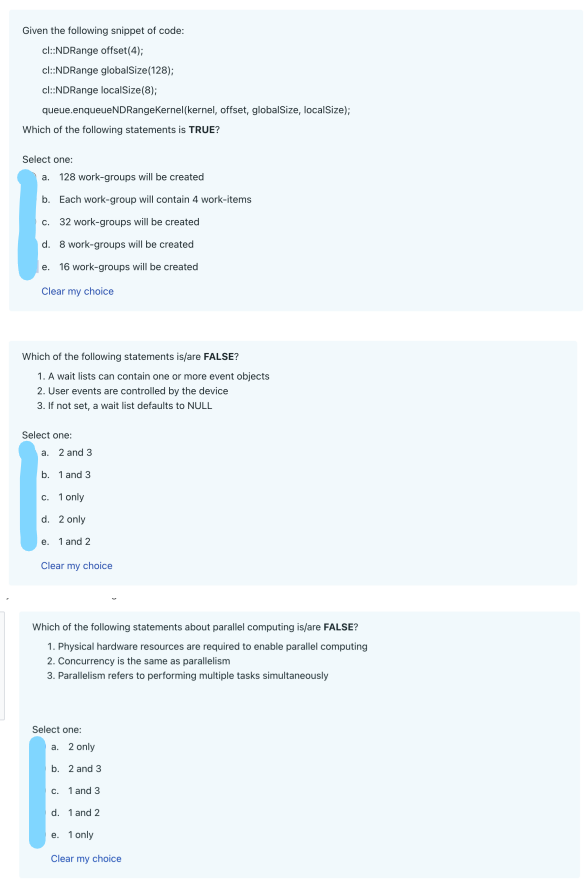Given the following snippet of code: cl::NDRange offset(4); cl::NDRange globalSize(128); cl::NDRange localSize(8); queue.enqueueNDRangeKernel(kernel, offset, globalSize, localSize); Which of the following statements is TRUE? Select one: a. 128 work-groups will be created b. Each work-group will contain 4 work-items c. 32 work-groups will be created d. 8 work-groups will be created e. 16 work-groups will be created Clear my choice Which of the following statements is/are FALSE? 1. A wait lists can contain one or more event objects 2. User events are controlled by the device 3. If not set, a wait list defaults to NULL Select one: a. 2 and 3 b. 1 and 3 c. 1 only d. 2 only e. 1 and 2 Clear my choice Which of the following statements about parallel computing is/are FALSE? 1. Physical hardware resources are required to enable parallel computing 2. Concurrency is the same as parallelism 3. Parallelism refers to performing multiple tasks simultaneously Select one: a. 2 only b. 2 and 3 c. 1 and 3 d 1 and 2
Given the following snippet of code: cl::NDRange offset(4); cl::NDRange globalSize(128); cl::NDRange localSize(8); queue.enqueueNDRangeKernel(kernel, offset, globalSize, localSize); Which of the following statements is TRUE? Select one: a. 128 work-groups will be created b. Each work-group will contain 4 work-items c. 32 work-groups will be created d. 8 work-groups will be created e. 16 work-groups will be created Clear my choice Which of the following statements is/are FALSE? 1. A wait lists can contain one or more event objects 2. User events are controlled by the device 3. If not set, a wait list defaults to NULL Select one: a. 2 and 3 b. 1 and 3 c. 1 only d. 2 only e. 1 and 2 Clear my choice Which of the following statements about parallel computing is/are FALSE? 1. Physical hardware resources are required to enable parallel computing 2. Concurrency is the same as parallelism 3. Parallelism refers to performing multiple tasks simultaneously Select one: a. 2 only b. 2 and 3 c. 1 and 3 d 1 and 2
Chapter7: Working With The Bash Shell
Section: Chapter Questions
Problem 15RQ
Related questions
Question

Transcribed Image Text:Given the following snippet of code:
cl::NDRange offset(4);
cl::NDRange globalSize(128);
cl::NDRange localSize(8);
queue.enqueueNDRangeKernel(kernel, offset, globalSize, localSize);
Which of the following statements is TRUE?
Select one:
a. 128 work-groups will be created
b. Each work-group will contain 4 work-items
c. 32 work-groups will be created
d. 8 work-groups will be created
e. 16 work-groups will be created
Clear my choice
Which of the following statements is/are FALSE?
1. A wait lists can contain one or more event objects
2. User events are controlled by the device
3. If not set, a wait list defaults to NULL
Select one:
a. 2 and 3
b. 1 and 3
c. 1 only
d. 2 only
e. 1 and 2
Clear my choice
Which of the following statements about parallel computing is/are FALSE?
1. Physical hardware resources are required to enable parallel computing
2. Concurrency is the same as parallelism
3. Parallelism refers to performing multiple tasks simultaneously
Select one:
a. 2 only
b. 2 and 3
c. 1 and 3
d. 1 and 2
e. 1 only
Clear my choice
Expert Solution
This question has been solved!
Explore an expertly crafted, step-by-step solution for a thorough understanding of key concepts.
Step by step
Solved in 3 steps

Knowledge Booster
Learn more about
Need a deep-dive on the concept behind this application? Look no further. Learn more about this topic, computer-science and related others by exploring similar questions and additional content below.Recommended textbooks for you

LINUX+ AND LPIC-1 GDE.TO LINUX CERTIF.
Computer Science
ISBN:
9781337569798
Author:
ECKERT
Publisher:
CENGAGE L

LINUX+ AND LPIC-1 GDE.TO LINUX CERTIF.
Computer Science
ISBN:
9781337569798
Author:
ECKERT
Publisher:
CENGAGE L